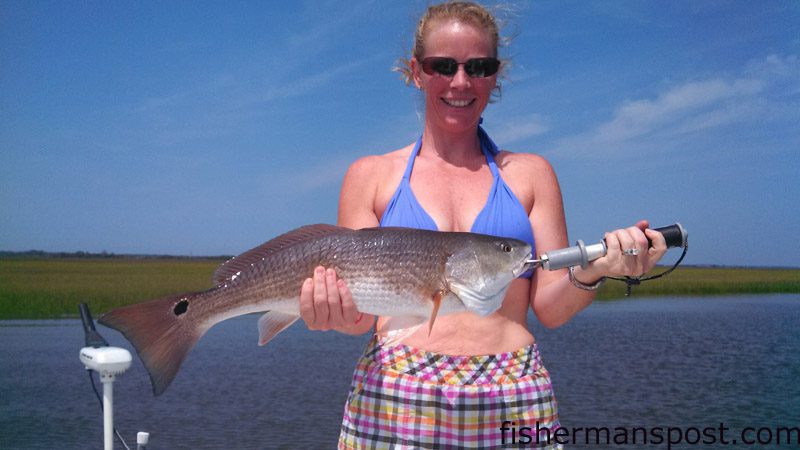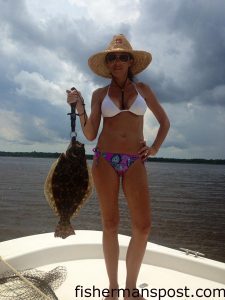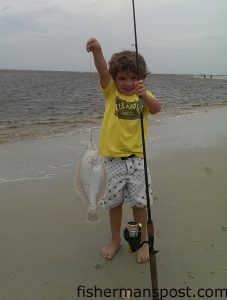Carolina Beach – August 14, 2014

Laura Dewitt with a red drum that struck a live mud minnow in the Cape Fear River near Bald Head Island while she was fishing with Capt. Robert Schoonmaker of Carolina Explorer.
Daniel, of Island Tackle and Hardware, reports that anglers are still seeing some solid speckled trout action in the lower Cape Fear River, with most of the fish feeding around grass islands, oyster rocks, and structure like docks. Anglers are fooling the specks with topwater plugs, suspending lures, soft plastics, and live baits fished under floats.
Flounder fishing in the river has been excellent as well, and anglers are also connecting with the flatfish in Snows Cut, the ICW, and Carolina Beach Inlet. Live finger mullet and menhaden are the top choices in flounder baits, but anglers are also hooking them on soft plastics pinned to jigheads.
Red drum are feeding on the flats in the lower Cape Fear, and there’s been some excellent topwater action with them lately. When the reds aren’t biting on top, soft plastics, spoons, and live baits will get their attention.
Sheepshead are looking for meals around inshore structure like docks, bridge pilings, and rocks in the area. Anglers can tempt the sheeps to bite live fiddler crabs fished tight to their homes.
Surf casters are connecting with some sea mullet and spot while baiting bottom rigs with shrimp and bloodworms.
Not many boats have been offshore recently, but those who’ve been bottom fishing are reporting that the grouper bite has slowed down a bit from a few weeks ago. Anglers are still hooking some gags 20-30 miles out and red and scamp groupers in the 40-50 mile range, and they’re fooling them with cigar minnows, sardines, and live baits.
There’s still some good wahoo action for boats making the run to the Gulf Stream, and anglers are connecting with a few dolphin in the blue water as well. Naked and skirted ballyhoo are fooling both.
Robert, of Carolina Explorer, reports that the flounder bite has improved substantially (and the fish are getting bigger). The lower Cape Fear River has been producing the best action recently, but anglers are also finding some fish in the ICW and Carolina Beach Inlet. Live finger mullet and peanut menhaden are the way to go for the flounder.
Red drum are also feeding in the lower Cape Fear, and they’ve been biting topwater plugs well recently. Soft plastics and live baits will get attention from the reds when they don’t want to bite on top. Some ladyfish, jack crevalle, and bluefish are feeding in the same areas as the reds and biting the same baits.
Anglers are also hooking some upper and over-slot drum in Carolina Beach Inlet on the same live baits the flatfish are biting.
Speckled trout action remains solid, with the majority of the fish coming from the Cape Fear River around Snows Cut and to the south. Casting topwater plugs and soft plastics around grass islands, oyster bars, and rocky structure is the way to tempt bites from the specks.
Jeff, of Seahawk Inshore Fishing Charters, reports that the easterly winds have helped clean up the water in the Cape Fear River a bit from all the recent rain, and the fishing has improved as a result. Anglers are connecting with speckled trout in the lower river while working MirrOlures and D.O.A. soft plastics around grass islands and oyster rocks.
Red drum and flounder are feeding in many of the same areas and in the bays and creeks off the lower river. Anglers can tempt both to bite live finger mullet, mud minnows, or Gulp shrimp.
More reds are falling for topwater plugs in the bays, and anglers are also tossing topwaters to schools of jack crevalle (some to 10 lbs.), ladyfish, and bluefish that are harassing schools of finger mullet on the surface.
Brenda, of Carolina Beach Pier, reports that anglers are hooking some spot, croaker, and bluefish on shrimp and bloodworms.
Some flounder are falling for live baits fished under the pier.
Alice, of Kure Beach Pier, reports that anglers are hooking sea mullet and some small flounder on bottom rigs baited with shrimp and bloodworms.
Some bluefish are falling for bottom rigs and Gotcha plugs that anglers are working from the pier.


